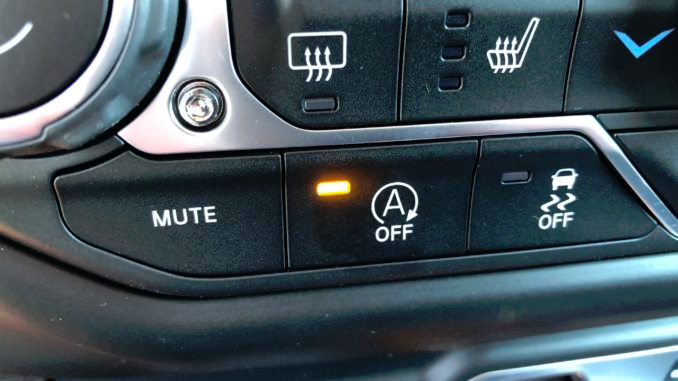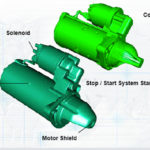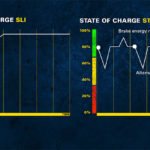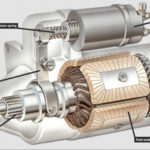Stop/start operation is both complicated and controversial. Despite the sophisticated algorithms it employs, no algorithm is perfect under all conditions. In addition, there are some “human factors” issues with respect to driver expectations and even nearby pedestrians, which stop/start brings.
Q: What are some “issues” with stop/start?
A: First, there’s the issue of added vehicle cost. On the microprocessor side, extra memory and programming for the ECM and other system controllers may not add a significant direct cost. Still, it does mean more memory is needed, and more programming and debugging are needed, thus adding to vehicle development time and test cycles.
Stop/start also adds direct hardware cost. For example, the starter is a larger, more complicated multiple-solenoid design, and more sensors may be needed to provide all the relevant information for the function. All of this adds cost and more things to go wrong (and more reasons for the “check engine light “ to come on).
Q: What about “human factors”?
A: For many drivers, the small shudder as the car restarts, as well as the small delay, are unnerving and even worrisome. The counterargument is “you’ll get used to it” and “this is a problem primarily for existing drivers, while those who new to cars…well, in ten (or so) years, stop/start will be viewed the “normal” mode.
Q: That’s it?
A: No, not at all. Drivers have complained about issues such as:
- Actual and perceived restart-delay when going from brake pedal to accelerator pedal (anywhere from about 300 msec to 500 msec)
- Vibration when the vehicle restarts.
- Vehicle rollback on hills when shifting from the brake to the accelerator.
- Heating and cooling systems change the temperature noticeably once the engine turns off.
- Nuisance stops and starts during maneuvers like parking.
- Anxiety as to whether the vehicle will restart.
- Startled or angry pedestrians and bicyclists when the engine restarts in front of them.
- Concerns – valid or not – about the added wear on their on-vehicle with thousands of additional restarts.
- Battery replacement intervals being reduced considerably.
- Problems using higher-power electrical accessories, such as police radios and oxygen concentrators (this is a serious concern).
Q: So, what can be done?
A: Depending on who you ask, the reactions to stop/start range from “I hate it” to “I suppose I’ll get used to it” to “it’s OK”. But enough people have complained that soon after it was introduced, automakers added a disable pushbutton to the many control on the car’s console (Figure 1). By pushing this button, the stop/start function is disabled for the ride. (Of course, the location differs on different models, and the symbol also differs somewhat between vehicle makes).

unnerving. (Image: Jeep Fan)
Q: That seems easy enough, so what’s the problem?
A: To meet fuel-consumption goals, stop/start must be an inherent and “normal” part of the car’s operation. To ensure this, drivers must push the override button each time the car is started after it has been turned off. If you run errands, and so make many stops, it has to be pressed again for each leg of the trip. For many drivers, pushing the “override” button becomes second nature right after starting the car. Other drivers learn to rest their non-brake foot on the accelerator lightly, so the stop/start is not activated.
Q: What if these solutions are still annoying or unacceptable to the driver?
A: Not to worry: creative people have devised “permanent” overrides for some cars. A company called TheJagWrangler LLC offers SmartStopStart, a family of modules that override the function (Figure 2). Thus far, the modules are available for most Jeep/Dodge/Chrysler and Chevy/Buick/Cadillac/GMC vehicle models.

or splicing needed), the stop/start function is disabled. (Image: TheJagWrangler LLC)
Q: Are these overrides hard to install?
A: No, they are fairly easy to install and do not quire tools, cutting wires, or making wire splices. Instead, the modules are installed inline in the designated wire harness by unplugging an existing connector, inserting the module with its matched mating connectors, and then reconnecting the existing harness. The target harness connector’s location differs with each vehicle; in some cases, it is under the hood. In others, it is under the driver’s console in the cabin
Q: Is it legal?
A: The vendor claims it is. Still, they strongly urge the vehicle owner to temporarily remove it when bringing the car to a dealer for any service. Their website states, “under the Magnusson-Moss Warranty Act, a manufacturer can only deny a warranty claim when an aftermarket component is installed if the dealer or manufacturer can prove that the aftermarket component caused the failure. To avoid any possible question ever arising from lack of knowledge of this product by the servicing dealer, we recommend removing the module before bringing the vehicle in for any service.”
Conclusion
Stop/start is apparently here to stay, as an increasing number of auto vendors include it in more of their vehicles to meet increasingly stringent fuel-consumption (mile/gallon or km/liter) mandates. It’s complicated in practice, with additional electromechanical hardware, electric circuitry, and software, and has drawbacks under the circumstances.
Whether car buyers (both new drivers and existing ones) will be comfortable with it over the coming years is a very open question, as it is contrary to every characteristic associated with a vehicle on the road with its engine “on” and running. To those who feel it’s worth anything to save fuel, it’s a worthy addition; to others who perhaps feel cars are already too complicated, costly, or confusing, it may be a major nuisance. So, is the “pain” of stop/start worth the “gain?” Will the possible shifty to all-electric vehicles make this a non-issue? Only time, car drivers, and auto-mileage regulatory factors will tell.
Related EE World Content
Are power systems up to the task of running self-driving cars?
Power modules lessen the load on internal combustion engines
Today in Engineering History: Internal Combustion Engine Patented
Hybrid EVs come to touring car racing
How bidirectional converters speed the design of dual-battery automotive systems
External References
There’s a lot of information available about stop/start, as there is almost anything related to cars: it’s a big industry that affects just about everyone in one way or another. Perhaps because stop/start is relatively new, contrary to tradition, and has many technical and driver-related issues, the content of these sites ranges from personal opinion to technical discussion to in-depth technical analysis. These are the useful sites and sources I reviewed for this article:
- Green Car Reports, “Don’t start-stop systems wear out your car’s starter?”
- Autocar, “Stop-start systems: is there a long-term impact on my car’s engine?”
- CarPro USA, “Understanding Stop/start Systems”
- Driving, “How It Works: Starters and automatic start-stop technology”
- Varta (Clarios), “Reasons why the start-stop system does not work”
- Varta (Clarios), “What is automatic start-stop and how does it work?”
- Varta (Clarios), “Why do I need a special battery for the automatic start-stop system?”
- Varta (Clarios), “Start-Stop”
- The Jag Wrangler, “SmartStartStop”
- The Truth About Cars, “The Problem With Start-Stop Systems”
- Best Ride, “Does Auto-Stop/Start Technology Wear Out Engine Components?”
- Practical Motoring, “Myth-busting: Does stop-start damage your engine?”
- NAPA, “Stop-Start Technology — Pros and Cons”
- Idle Smart, “Pros and Cons of Automatic Engine Stop/start Solutions”
- How Stuff Works, “Love It or Hate It: Stop-start Technology Is Here to Stay”
- Wikipedia, “Start-stop system”
- STMicroelectronics, “48V Start-Stop System”
- Daimler, “Under the microscope: ECO stop/start: Sophisticated technology gives the highest levels of efficiency”
- Argonne National Laboratory, “Start and Restart Effects on Modern Vehicle Starting Components”
- Bosch, “Full power for stop/start”
- How a Car Works, “How the starting system works”
- Your Mechanic, “How Does a Starter Motor Work?”
- General Motors, “Cadillac’s Electric Self Starter Turns 100”
- Elreg Distributors, “The Evolution of the Starter Motor”
- PR Newswire, “ZMJ and CRCI to Acquire Bosch’s Starters and Generators Business”
- TechLink, “Enhanced Starter Motor Operation in Engine Stop/Start Systems”
- JeepFan, “How Electronic Start Stop ESS Works on the Jeep Wrangler JL”
- Autoblog/Verizon Media, “Mazda introduces clever start-stop system with direct injection”







Leave a Reply